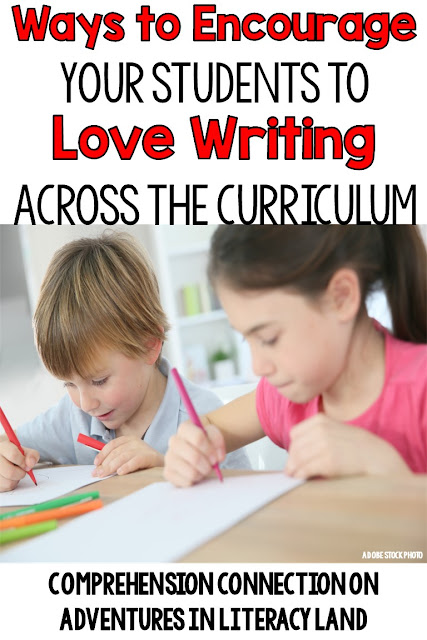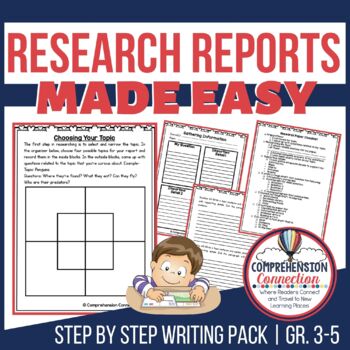Sound effects? Powerful quote? Leading questions? No matter what hook idea students choose to use as the opener for their papers, students still need to be able to carry out a central idea in well structured paragraphs and this takes practice. If your days are like mine, we are hard-pressed to find all the time we need to build writing skills to the degree we'd like no matter what grade level you're in. If that describes your reality, then perhaps today's post will give you a new perspective on how to incorporate writing throughout the day, and therefore build those writing skills.

Earlier this week, Melissa mentioned in her post that the teachers in Virginia were gearing up for the state writing assessment. In our state, students are assessed for the first time in fifth grade, and as we know, the fifth grade teachers are not miracle workers. Writing skills build over time, and struggling readers are typically struggling writers, so in order to build strong writers, our writing programs need to include these key components:
- Informal writing opportunities
- Modeling and practice with Process Writing
- and Genre Writing experiences.
Each type of writing addresses specific skills. Informal writing is intended to build writing fluency while process writing develops writing skills and abilities, and genre writing teaches organizational patterns of writing. It is the informal and genre writing that can be incorporated into the content areas offering struggling writers a "double dip" of writing.
By increasing informal writing opportunities and genre writing in the content areas, we improve writing skills, reinforce content learning, and address reading comprehension of the content for deeper understandings. If we weave writing through all of our subjects, students learn that writing is a tool they can use to learn and express their thoughts about it.
What's considered informal writing? Informal writing includes using journals of various types for prompted writing and choice writing, responding to literature, and writing to learn. With these types of experiences, students should be free from grading, but rather assessment is more about encouraging the thinking and effort. Below are a list of ideas for each writing option:
Informal Writing Opportunities
Journal writing can be used much more than just morning work. I've seen in many classrooms journals are done in the morning with the prompt of the day, but try to expand your use of them. There are far more options than just a daily prompt. Below are a few options you might try. Don't limit to just one classroom journal. Consider including them for each subject you teach. When you think about how you can incorporate additional writing opportunities, you'll find your kids will need more than one.
- Personal Journals-allow freedom of expression about whatever is important to the child.
- Writer's Notebooks-helps students keep track of and add their ideas for writing opportunities they may use later.
- Family Message Books-these journals are used as a way for children to communicate feelings and opinions with their parents and for parents to provide guidance.
- Speedwriting-students are provided an amount of time to just write their ideas on a topic. This works well as a schema building activity with content areas.
- Sensory Writing-students write what they hear, see, feel, smell, and taste with a certain topic.
- Memory Writing-students write about memories related to a topic...walking in the woods, power outages, beginning school, etc.
Responding to Reading is another great way to weave in additional writing (and check comprehension at the same time). From graphic organizers to interactive notebooks to questions and exit tickets, the options are almost endless. Just make it purposeful and linked to the learning your students have completed with the chosen text in reading.
- Response Journals-These ideas are almost endless...letter to a friend about reading, a play, song, news report, blogging, wanted ad, etc.
- Response charts-Quotes and Connections
- Response questions-Reading to find answers to questions, and learning to respond in complete sentences are helpful to students in building sentence fluency.
- Blogging and Social Media-The internet is here to stay, so it's important that we embrace it and learn how to use it for learning. Edmodo is a great website you might try for monitored class discussions.
Writing to Learn is the third informal writing option. Students use writing when they put together interactive notebooks, lapbooks, and even when they take notes about their content. Again, graphic organizers and exit tickets are used for learning too.
- Learning Logs and Interactive Notebooks-Students can take photos, graphics from the content area, and foldables, glue them in their notebooks, and go one step further to record their thoughts about them.
- Questioning-Give students key questions to respond to at stopping points within the lesson. Students can use information from their learning and work on writing well thought out responses.
- Exit Cards-These are fairly common, and very quick to include. [Here's] a great little freebie from Mad Science Lessons on Teachers Pay Teachers
- Various forms of the KWL Chart
- Writing projects-news articles, bumper stickers, letters to people in history, lab reports, epitaphs, memories of learning, boasts or brags about what they've done well, posters, interviews and more.
Genre Writing Experiences
You might be wondering how genre writing experiences can tie into the content areas. and what genre writing is. We study genres in reading, but what does it have to do with writing? Some genres lead writers to use organizational patterns. Teaching text structure has become a focus with the Common Core with reading comprehension, but applying that knowledge in writing can reinforce learned concepts. We have three basic patterns; fictional plot structures, exposition which includes description, sequential, and compare/contrast, and persuasion which includes cause/effect and problem/solution. Understanding the organizational patterns applies to writing as well as in topics we read with science, history, and math. Take for example studies of erosion. Writing a problem and solution essay would help students learn about ways they might prevent erosion, but also how to organize those ideas in their writing too. Another example would be writing lab reports. Lab reports are done sequentially (or chronologically), and when writing a lab report, teachers can help students learn to use transition words to help their writing flow sequentially.
Here are a few ideas you might try. (For young writers, some of these can be done in a shared writing fashion versus independently. Scaffold as you need.)
- Personal Experience Stories
- Writing Frames
- Graphic Organizers
- Me Museums (writings about life...include timeline, pictures/captions, maps)
- Fictional Stories using information learned
- Character Webs
- Plot Cubes
- Compare/Contrast writing (Indian Tribes, Landforms, Electrical Circuits)
- Cause/Effect writing (Effects of Pollution, Results of War, Laws)
- Persuasion (What XXX means to me, School Lunch)
Process Writing
I don't think I need to spend a great bit of writing space to talk about
process writing. It is simply work that you take through the full writing process (prewriting, drafting, revising, proofread/editing, publishing). Students should always have at least one piece of work going through the writing process at all times, and from my experience, the greatest need for struggling kids is the
revising stage. For many of my kids, their understanding of revising is just recopying it neater. It's taken a long time to correct the misunderstanding, and now, the published work has a much different look from the first draft. For struggling students, I highly recommend bringing in an assistant or parent volunteer who loves working one-on-one as this is the most effective way to help students hear and see errors they've made.
When time is limited, my hope is that writing won't be the activity that gets cut now that you've read this. Instead of cutting, work to weave it in. Writing should be a common thread throughout all of the core subjects. It improves reading comprehension, reinforces learning, and improves writing fluency and expression. Plus, writing is just plain fun!














